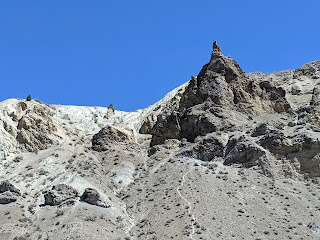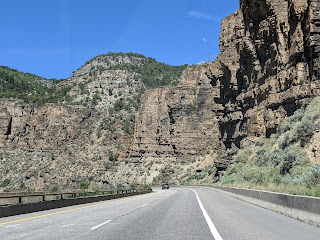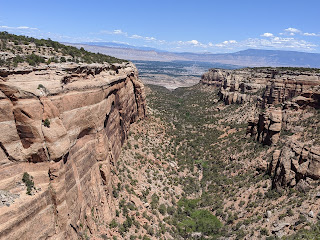Two months ago exactly, Steven and I embarked on our first road trip during this pandemic because we had just become grandparents for the first time. We couldn't wait to drive out to San Francisco to see our son, Alexander, his wife, Cory, and their daughter, Max, who had been born on May 24th. From there, we'd planned a very circuitous route home via the Pacific Northwest so we could see some of the state capitals and national parks. We were excited beyond words to meet and spend time with Max but also wary traveling far from home during the coronavirus.
We couldn't resist stopping at the evocatively named Cold Shivers Point!
We felt comfortable embarking on the month-long trip as we were armed with lots of hand sanitizer, face masks, soap and disposable wipes. Instead of having to stop to eat at restaurants, we thought it best to bring a cooler filled with sandwich fixings and a Coleman stove. That way we could stop at rest areas and fire up the stove for a more relaxing meal.
After driving westward for about five hours, we reached Colorado National Monument in the western part of the state. We read the park was created in 1911 and "preserves one of the grandest landscapes of the American West." The park was part of the greater Colorado Plateau which also comprised other geologic wonders like the Grand Canyon, Bryce Canyon, and Arches and Canyonlands national parks.
Since we had limited time, we chose to drive the length of the park's Rim Rock Drive as it was described one of the grandest scenic drives in the American West. No way could we resist that!
This was the first sign we noticed about the steps visitors should take because of Covid-19 in the park.
We read that around 70-10 million years ago, the Redlands Fault lifted the layered sedimentary rocks of the Monument above the Grand Valley. Since then, erosion had carved these magnificent, steep-walled, flat-bottomed canyons that were literally hanging above the Colorado River.
Humans have occupied this canyon landscape for 12,000 years leaving tools, shelters, and rock art behind.
We stopped next at Ute Canyon View so we could walk along its interpretive trail. There we were struck by how tough it would have been for the Ute people getting all the resources required to meet life's survival challenges from the land. Imagine their having to gather plants for food and medicine, hunting animals and also locating materials for tool-making in such a harsh environment.
Although flowing water was the force that carved these canyons, the shape and direction of the canyons were influenced by the rocks themselves. Summer rainstorms, like the flash flood that occurred in 2010 in No Thoroughfare Canyon, have caused massive flooding. As floodwaters move boulders and smaller rocks downstream, they wear away underlying bedrock, thereby helping to carve the canyon. Fortunately, thunderstorms, while violent, are usually short.
Nobody had to wonder why this viewpoint was called Fallen Rock! Instead of toppling 'face forward' when it toppled from thee cliff, Fallen Rock slid 'feet forward' more than 100 feet until it came to a stop on the debris slope below, likely thousands of years ago.
About halfway through the park was Highland View.
Another spectacular viewpoint was Coke Ovens where erosion has produced unusual shapes on the Monument's landscape. As the protective Kayenta Formation layers erode from the ridge in front of us, the softer Wingate Formation beneath it was exposed in a unique way. The Monument's first visitors thought the shapes looked like man-made structures called coke ovens, thereby lending the name. Coke ovens were used to transform coal into coke, a fuel that produced little to no gas when burned.
The Wingate Formation was a tan sandstone comprised of many layers that were deposited in a desert environment where wind-swept sands were accumulated and buried.I was blown away that an environment like this could also be found in North Africa's Sahara Desert.
The 450-foot high Independence Monument was the largest free-standing rock formation in the park. Once part of a massive rock wall, it separated two canyons. As the forces of erosion ever so slowly enlarged the canyons, the dividing wall was narrowed and weakened. Weathering and erosion took place rapidly along natural fractures where the rock was most vulnerable. That resulted in the wall being breached and parts of it collapsing. The freestanding monolith known as Independence Monument was the remnant of the once solid rock wall. Geologists have predicted that it will gradually succumb to time and weather. Granted that may take centuries to happen, we were still very happy to have seen this part of the Monument!
Having already toured the major national parks in the Southwest, it almost seemed like there should be Balanced Rock View as that was a common feature in other parks.
From westernmost Colorado we headed to northeastern Utah before stopping for the night in Salina. We got off the beaten track, first though, to explore the region's outlaw country!
Hidden in these canyons the infamous Butch Cassidy, Flat Nose George, Elza Lay, Kid Curry, and others eluded lawmen who pursued them in the late 1800s. In the 1850s Chief Wakara escaped into the hills with as many as 1,400 horses he had stolen from ranches in California. He came across the Spanish Trail which had been forged by Spanish explorers about 1800. Later it became a route for slave traders who sold Native Americans for as much as $200 each in Mexico City. That was a fact I had never heard of before. Had you?
The real Butch Cassidy didn't look nearly as hunky as the actor who portrayed him, Paul Newman!
What a great first day of our trip this had been exploring some of the gorgeous Wild West! For so many years now Steven and I have spent as many as six months each year visiting far-off lands and other parts of the US that exploring some of what our 'colorful state' of Colorado had to offer was past due.
Next post: Hiking in eastern Nevada's Great Basin National Park and the Ward Charcoal Ovens State Historic Park.
Posted on August 11th, 2020, from Lincoln, Nebraska, as Steven and I are heading east on another road trip, this time to meet our second granddaughter, Clara, who was born four weeks ago today in Chicago. From there it will be a very roundabout route to a state park on Florida's panhandle, our ultimate destination! Please take care of yourself and your loved ones and stay safe during these troubling times.






















































Spectacular vistas made more beautiful with the brilliant blue skies above you !!
ReplyDeletexo Lina xo
I am absolutely agree with Lina, beautiful pictures especially you. Take care, love xoxoxo
ReplyDeleteGloria